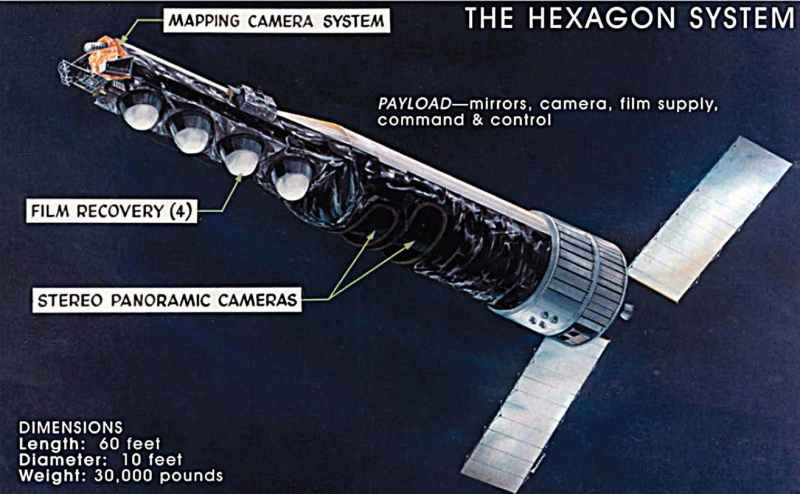When the United States launched the KH-9 Hexagon spy satellite into orbit atop a Titan IIID rocket in 1974, it brought a calibration target along for the ride: the Infra-Red Calibration Balloon (IRCB) S73-7. This 66 cm (26 inch) diameter inflatable satellite was ejected by the KH-9, but failed to inflate into its intended configuration and became yet another piece of space junk. Initially it was being tracked in the 1970s, but vanished until briefly reappearing in the 1990s. Now it’s popped up again, twenty-five years later.
As noted by [Jonathan McDowell] who tripped over S73-7 in recent debris tracking data, it’s quite possible that it had been tracked before, but hidden in the noise as it is not an easy target to track. Since it’s not a big metallic object with a large radar cross-section, it’s among the more difficult signals to reliably pick out of the noise. As can be seen in [Jonathan]’s debris tracking table, this is hardly a unique situation, with many lost (XO) entries. This always raises the exciting question of whether a piece of debris has had its orbit decayed to where it burned up, ended up colliding with other debris/working satellite or simply has gone dark.
For now we know where S73-7 is, and as long as its orbit remains stable we can predict where it’ll be, but it highlights the difficulty of keeping track of the around 20,000 objects in Earth orbit, with disastrous consequences if we get it wrong.
















Did it pass the Event Horizon?
Not sure, as the only transmission was unrecognizable. Decoding does not helped much: “Liberate tuteme ex inferis”?
PLEASE TYPE.ECDFS736475 /
wish you luck
I would have never guessed that satellite was 60′ x 10′. That’s massive for a few cameras.
err ….. yes, but what else can it do? (except create litter)
It had to fit on the top of a rocket stack. The satellite was effectively the “nose” of the rocket during launch, and then separated.
At least in the 70s if you didn’t fit a proper sized nose cone onto your rocket, it wasn’t going to function as a rocket.
and 30,000 pounds
wow
That’s the size of the balloon. The balloon is the satellite referenced in this article.
The balloon, as noted in the article, is 66cm, and hence hard to track. The satellite (that thing in the picture up top) is 53.1×10.0′, or 16.2×3.05m.
1970’s high resolution film cameras plus four pods that carry up to 220kg of film (and that’s special lightweight film too), can survive re-entry and get caught by a sky hook… the whole thing is bonkers.
https://en.wikipedia.org/wiki/KH-9_Hexagon
Big cameras, lots of film. Across all 19 HEXAGONs, they achieved a ground coverage of 2.3 billion square kilometres. If evenly distributed, they would have photographed the entire surface of the Earth nearly 5 times over.
KH-9 wasn’t nicknamed “Big Bird” for nothing!
Does the Stereo Panoramic Camera still work? Can pictures be downloaded?
Not sure. These were analog film cameras, I suppose?
If so, they’d rather “send” physical films back, with a parachute or something.
I mean, technically it was possible to record on magnetic tape and send picture data back, but..
The film cameras had better resolution in these days, I guess.
Yes, these early keyhole satellites (the KH in KH-9) had film cameras. The rolls of film would feed past the camera in into one of the 4 recovery vehicles. Those would be jettisoned and drop until a parachute deployed. An aircraft would then snatch them form the air by snagging the lines. (At least the earlier versions of these satellites worked that way.) The 1974 flight was at the very tail end of the program, which was replaced by electronic systems that transmitted their data back down.
No. the KH9-9 spy satellite re-entered Earth’s atmosphere in 1975.
yes an/it will Be able to transmit all shots
was only the balloon lost or both the balloon and the satilight?
Only the balloon was lost. The huge metal satellite was never lost.
The balloon is the satellite that was untracked all this time. The satellite with the cameras reentered Earth’s atmosphere in 1975. These satellites orbited only about 100 miles altitude, so they didn’t have a very long orbital life.
The satellite with the cameras re-entered Earth’s atmosphere in 1975.
Hexagons are the bestagons.
How 311 of you
The big satellite (“Big Bird”) was not the one that’s hard to track, though today it’s pretty hard to believe a 60 foot satellite was sent up for 4 months of service.
https://www.nbcnews.com/id/wbna44568418
Declassified in 2011
> According to documents released by the NRO, each HEXAGON satellite mission lasted about 124 days, with the satellite launching four film return capsules that could send its photos back to Earth. An aircraft would catch the return capsules in mid-air by snagging their parachutes following the canisters’ re-entry.
The headline & banner image do kind of bury the lead that this is in fact a small calibration balloon not the actual thing in the picture.
Although the whole Hexagon thing is so bonkers it’s always worth a re-visit.
ya Done great- MORE TO Ply
It was just under deep cover.